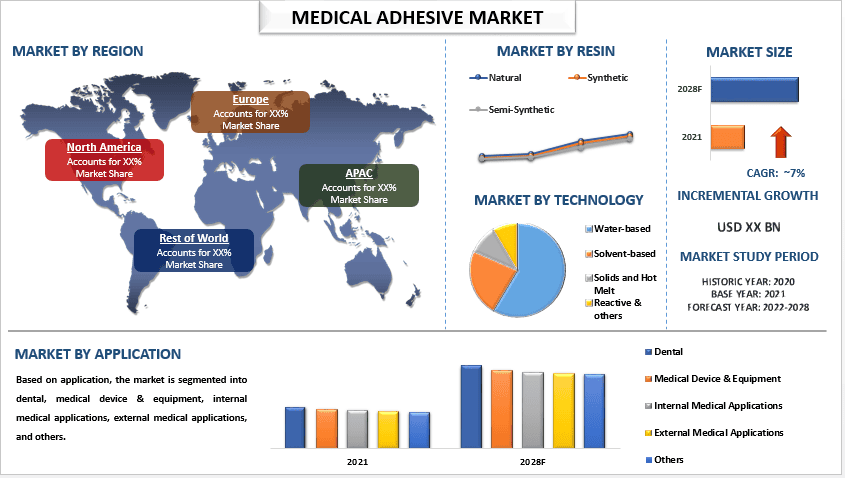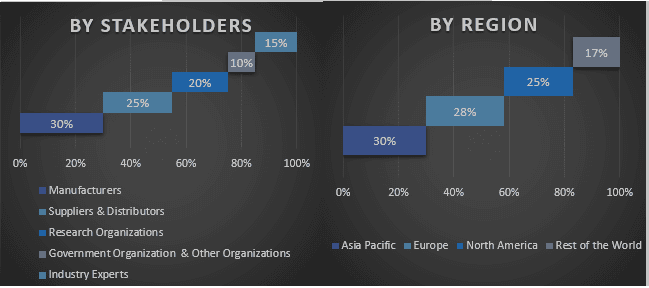- Strona główna
- O nas
- Branża
- Usługi
- Czytanie
- Kontakt
Rynek medycznych środków adhezyjnych: bieżąca analiza i prognoza (2022-2028)
Nacisk na żywicę (naturalną, syntetyczną, półsyntetyczną); technologię (na bazie wody, na bazie rozpuszczalników, stałe i topliwe, reaktywne i inne); zastosowanie (dentystyczne, urządzenia i sprzęt medyczny, wewnętrzne zastosowania medyczne, zewnętrzne zastosowania medyczne, inne); oraz region/kraj

Oczekuje się, że globalny rynek medycznych środków klejących będzie rósł w znaczącym tempie około 7% w okresie prognozy. Medyczne środki klejące są używane do łączenia produktów medycznych, takich jak strzykawki, filtry do dializ, worki na krew i złącza rurek. Te produkty medyczne są zwykle wykonane z szeregu materiałów syntetycznych, w tym tworzyw sztucznych, które są trudne do łączenia, takich jak PEEK, PE i PP. Ponadto medyczne środki klejące, takie jak biokompatybilne medyczne środki klejące, są coraz częściej stosowane w urządzeniach medycznych ze względu na ich właściwości nietoksyczne dla komórek, nieuczulające i niedrażniące. Również sportowcy używają klejów, ponieważ potrzebują hydrofobowości klejów silikonowych. Ponieważ te cechy sprawiają, że idealnie nadają się do noszenia podczas uprawiania sportów wodnych, takich jak nurkowanie, pływanie i inne aktywności. Dlatego powyższe czynniki odpowiadają za wzrost rynku.
Baxter International Inc., 3M Company, Johnson & Johnson, Avery Dennison Corporation, Henkel AG & Co. KGaA, Ashland Inc., Cohera Medical Inc., Dymax Corporation, Dentsply Sirona, Adhezion Biomedical LLC to jedni z kluczowych graczy na rynku. Gracze ci podjęli szereg fuzji i przejęć wraz z partnerstwami, aby ułatwić klientom dostęp do zaawansowanych technologicznie i innowacyjnych produktów/technologii.
Informacje przedstawione w raporcie
„Wśród żywic, kategoria syntetyczna odnotuje solidny CAGR w okresie prognozy”
Na podstawie żywicy rynek jest podzielony na naturalny, syntetyczny i półsyntetyczny. Kategoria syntetyczna odnotuje wyższy CAGR w okresie prognozy. Jedną z żywic syntetycznych jest żywica silikonowa, która jest wysoce preferowana przy wytwarzaniu medycznych środków klejących. Silikony są wytwarzane z czystego metalu krzemowego uzyskiwanego w procesie redukcji piasku kwarcowego i koksu. Ponadto silikony są dostępne w postaci płynów silikonowych, żeli, elastomerów i żywic. Na przykład w kwietniu 2021 roku firma 3M ogłosiła nowe uzupełnienie nowej klasy klejów silikonowych, taśmę medyczną 2484 3M™ Single Coated Film z klejem silikonowym Hi-Tack na podkładzie, która jest bezpieczna i delikatna, aby wspierać zgodność urządzeń przez użytkowników końcowych. Najnowszy klej silikonowy 2484 3M Hi-Tack jest dopasowujący się, oddychający, minimalizuje usuwanie komórek skóry i umożliwia noszenie przez ponad siedem dni, co czyni go idealnym wyborem do stosowania na delikatnej skórze.
„Wśród technologii, kategoria ciał stałych i topliwych odnotuje solidny CAGR w okresie prognozy”
Na podstawie technologii rynek jest podzielony na wodne, rozpuszczalnikowe, ciała stałe i topliwe, reaktywne i inne. Wśród nich ciała stałe i topliwe utrzymają znaczący udział w rynku w 2021 roku. Wynika to głównie z jego jakości środka wiążącego w 100% w stanie stałym, który jest nakładany w stanie stopionym, który tworzy wiązania podczas chłodzenia. Jego formuła zawsze zawiera trzy główne surowce: polimery, takie jak etylen, kopolimery itp. Na przykład w maju 2022 roku firma Bostik wprowadziła na rynek swoje nowe kleje o nazwie Ethylene Vinyl Acetate (EVA) i Polyolefin (PO) Hot Melt Adhesives, które są wygodne i spełniają wymagania środowiskowe.
„Wśród zastosowań, segment zastosowań urządzeń i sprzętu medycznego odnotuje solidny CAGR w okresie prognozy”
Na podstawie zastosowania rynek jest podzielony na stomatologię, urządzenia i sprzęt medyczny, wewnętrzne zastosowania medyczne, zewnętrzne zastosowania medyczne i inne. Przewiduje się, że segment zastosowań urządzeń i sprzętu medycznego będzie najszybciej rozwijającym się zastosowaniem na rynku globalnym w nadchodzących latach. Wynika to głównie z niektórych jego zastosowań, ponieważ utwardza się w kilka sekund po wystawieniu na działanie światła UV/widzialnego, wysoka wytrzymałość połączenia, zoptymalizowana szybkość instalacji zapewnia szybsze przetwarzanie oraz lepszą i bardziej wydajną ogólną wydajność przy jednoczesnym zachowaniu opłacalności. Kleje te gwarantują wytrzymanie trudnych warunków użytkowania produktu i spełniają wszystkie najważniejsze przepisy. Na przykład Henkel Loctite AA 3921 UV Medical Adhesive to utwardzany światłem klej na bazie akrylu, który został opracowany w celu zapewnienia elastycznych i trwałych połączeń podczas łączenia wrażliwych na naprężenia tworzyw sztucznych. Typowe zastosowania AA 3921 obejmują łączenie kaniul ze stali nierdzewnej z piastami, strzykawkami i lancetami do zespołów igieł.
„Azja i Pacyfik utrzymają znaczący udział w rynku”
W 2021 roku oczekuje się, że Azja i Pacyfik będą rosły w znacznym CAGR w okresie prognozy. Wynika to głównie z dużej populacji w regionie Azji i Pacyfiku wraz z rosnącą świadomością opieki zdrowotnej, a wyższy wskaźnik infekcji ran jest głównym czynnikiem wzrostu dla tego regionu. Ponadto Chiny są największym konsumentem medycznych środków klejących w tym regionie, ponieważ kraj ten jest gęsto zaludniony, co napędza wzrost rynku. Ponadto wielu pacjentów z cukrzycą lub rosnąca liczba przypadkowych przypadków w regionie również prawdopodobnie przyczyni się do rozwoju przemysłu medycznych środków klejących. Ponadto rząd inwestuje również w tworzenie nowych możliwości na rynku. Na przykład Indie i Rosja wyznaczyły dwustronny cel handlowy w wysokości 30 miliardów dolarów do 2025 roku. Oczekuje się, że handel wzrośnie o dodatkowe 5 miliardów dolarów rocznie, z możliwościami w zakresie farmaceutyków i urządzeń medycznych, minerałów, stali i chemikaliów, co przyspiesza wzrost rynku. Dlatego Azja i Pacyfik rosną dzięki wzrostowi populacji i potrzebie lepszych placówek medycznych w regionie.
Powody, dla których warto kupić ten raport:
- Badanie obejmuje analizę wielkości rynku i prognozowanie, zweryfikowane przez uwierzytelnionych kluczowych ekspertów branżowych.
- Raport przedstawia szybki przegląd ogólnych wyników branży na pierwszy rzut oka.
- Raport obejmuje dogłębną analizę czołowych podmiotów branżowych, koncentrując się przede wszystkim na kluczowych finansach przedsiębiorstw, portfolio produktów, strategiach ekspansji i najnowszych osiągnięciach.
- Szczegółowe badanie czynników napędzających, ograniczeń, kluczowych trendów i możliwości panujących w branży.
- Badanie kompleksowo obejmuje rynek w różnych segmentach.
- Dogłębna analiza branży na poziomie regionalnym.
Opcje dostosowywania:
Globalny rynek medycznych środków klejących można dodatkowo dostosować zgodnie z wymaganiami lub dowolnym innym segmentem rynku. Poza tym UMI rozumie, że możesz mieć własne potrzeby biznesowe, dlatego nie wahaj się z nami skontaktować, aby otrzymać raport, który w pełni odpowiada Twoim wymaganiom.
Spis treści
Metodologia badań dla analizy rynku medycznych klejów (2022-2028)
Analiza historycznego rynku, szacowanie obecnego rynku i prognozowanie przyszłego rynku globalnego rynku medycznych klejów to trzy główne kroki podjęte w celu stworzenia i analizy adopcji medycznych klejów w głównych regionach na całym świecie. Przeprowadzono wyczerpujące badania wtórne w celu zebrania danych historycznych dotyczących rynku i oszacowania obecnej wielkości rynku. Po drugie, aby zweryfikować te spostrzeżenia, wzięto pod uwagę liczne ustalenia i założenia. Ponadto przeprowadzono wyczerpujące wywiady podstawowe z ekspertami branżowymi w całym łańcuchu wartości globalnego rynku medycznych klejów. Po założeniu i zatwierdzeniu danych rynkowych poprzez wywiady podstawowe, zastosowaliśmy podejście odgórne/oddolne do prognozowania całkowitej wielkości rynku. Następnie przyjęto metody podziału rynku i triangulacji danych w celu oszacowania i analizy wielkości rynku segmentów i podsegmentów branży. Szczegółowa metodologia jest wyjaśniona poniżej:
Analiza historycznej wielkości rynku
Krok 1: Dogłębne badanie źródeł wtórnych:
Przeprowadzono szczegółowe badania wtórne w celu uzyskania historycznej wielkości rynku medycznych klejów za pośrednictwem wewnętrznych źródeł firmy, takich jak raporty roczne i sprawozdania finansowe, prezentacje wyników, komunikaty prasowe itp., oraz źródeł zewnętrznych, w tym czasopism, wiadomości i artykułów, publikacji rządowych, publikacji konkurencji, raportów sektorowych, baz danych stron trzecich i innych wiarygodnych publikacji.
Krok 2: Segmentacja rynku:
Po uzyskaniu historycznej wielkości rynku medycznych klejów przeprowadziliśmy szczegółową analizę wtórną w celu zebrania historycznych spostrzeżeń rynkowych i udziału dla różnych segmentów i podsegmentów dla głównych regionów. Główne segmenty zawarte w raporcie to żywica, technologia i zastosowanie. Ponadto przeprowadzono analizy na poziomie krajowym w celu oceny ogólnego wdrożenia modeli testowania w danym regionie.
Krok 3: Analiza czynnikowa:
Po uzyskaniu historycznej wielkości rynku różnych segmentów i podsegmentów przeprowadziliśmy szczegółową analizę czynnikową w celu oszacowania obecnej wielkości rynku medycznych klejów. Ponadto przeprowadziliśmy analizę czynnikową przy użyciu zmiennych zależnych i niezależnych, takich jak różne żywice, technologie i zastosowania na rynku medycznych klejów. Przeprowadzono dokładną analizę scenariuszy popytu i podaży, biorąc pod uwagę najważniejsze partnerstwa, fuzje i przejęcia, ekspansję działalności i wprowadzenie produktów na rynek w sektorze medycznych klejów na całym świecie.
Szacowanie obecnej wielkości rynku i prognoza
Określanie obecnej wielkości rynku: Na podstawie praktycznych spostrzeżeń z powyższych 3 kroków doszliśmy do obecnej wielkości rynku, kluczowych graczy na globalnym rynku medycznych klejów i udziałów w rynku poszczególnych segmentów. Wszystkie wymagane udziały procentowe i podziały rynku zostały określone przy użyciu wyżej wymienionego podejścia wtórnego i zweryfikowane za pomocą wywiadów podstawowych.
Szacowanie i prognozowanie: W przypadku szacowania i prognozowania rynku przypisano wagi różnym czynnikom, w tym czynnikom napędowym i trendom, ograniczeniom i możliwościom dostępnym dla interesariuszy. Po przeanalizowaniu tych czynników zastosowano odpowiednie techniki prognozowania, tj. podejście odgórne/oddolne, aby uzyskać prognozę rynkową na rok 2028 dla różnych segmentów i podsegmentów na głównych rynkach na całym świecie. Metodologia badań przyjęta do oszacowania wielkości rynku obejmuje:
- Wielkość rynku branży pod względem przychodów (USD) i wskaźnik adopcji rynku medycznych klejów na głównych rynkach krajowych
- Wszystkie udziały procentowe, podziały i zestawienia segmentów i podsegmentów rynku
- Kluczowi gracze na globalnym rynku medycznych klejów pod względem oferowanych produktów. Ponadto strategie rozwoju przyjęte przez tych graczy w celu konkurowania na szybko rozwijającym się rynku
Walidacja wielkości rynku i udziałów
Badania podstawowe: Przeprowadzono szczegółowe wywiady z kluczowymi liderami opinii (KOL), w tym kadrą kierowniczą najwyższego szczebla (CXO/wiceprezesi, szef sprzedaży, szef marketingu, szef operacyjny, szef regionalny, szef krajowy itp.) w głównych regionach. Następnie podsumowano wyniki badań podstawowych i przeprowadzono analizę statystyczną w celu udowodnienia postawionej hipotezy. Dane wejściowe z badań podstawowych zostały połączone z wynikami badań wtórnych, dzięki czemu informacje zamieniły się w praktyczne spostrzeżenia.
Podział uczestników badań podstawowych w różnych regionach

Inżynieria rynku
Zastosowano technikę triangulacji danych, aby ukończyć ogólne szacowanie rynku i uzyskać precyzyjne dane statystyczne dla każdego segmentu i podsegmentu globalnego rynku medycznych klejów. Dane zostały podzielone na kilka segmentów i podsegmentów po przestudiowaniu różnych parametrów i trendów w obszarach rodzajów produktów i kanałów dystrybucji na globalnym rynku medycznych klejów.
Główny cel badania globalnego rynku medycznych klejów
W badaniu wskazano obecne i przyszłe trendy rynkowe globalnego rynku medycznych klejów. Inwestorzy mogą uzyskać strategiczne spostrzeżenia, na których mogą oprzeć swoje decyzje dotyczące inwestycji na podstawie analizy jakościowej i ilościowej przeprowadzonej w badaniu. Obecne i przyszłe trendy rynkowe określiły ogólną atrakcyjność rynku na poziomie regionalnym, zapewniając uczestnikom branży platformę do wykorzystania niewykorzystanego rynku, aby skorzystać z przewagi pioniera. Inne cele ilościowe badań obejmują:
- Analiza obecnej i prognozowanej wielkości rynku medycznych klejów pod względem wartości (USD). Ponadto analiza obecnej i prognozowanej wielkości rynku różnych segmentów i podsegmentów
- Segmenty w badaniu obejmują obszary żywicy, technologii i zastosowania.
- Definiowanie i analiza ram regulacyjnych dla medycznych klejów
- Analiza łańcucha wartości związanego z obecnością różnych pośredników, wraz z analizą zachowań klientów i konkurentów w branży.
- Analiza obecnej i prognozowanej wielkości rynku medycznych klejów dla głównego regionu.
- Główne kraje regionów badane w raporcie to Azja i Pacyfik, Europa, Ameryka Północna i reszta świata.
- Profile firm działających na rynku medycznych klejów i strategie rozwoju przyjęte przez uczestników rynku w celu utrzymania się na szybko rozwijającym się rynku
- Dogłębna analiza regionalna branży
Powiązane Raporty
Klienci, którzy kupili ten przedmiot, kupili również










